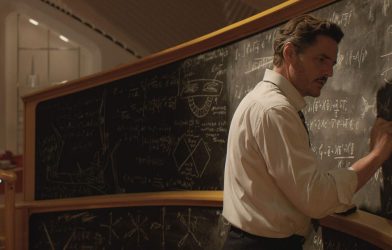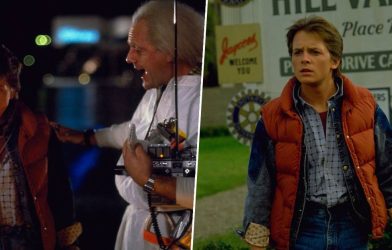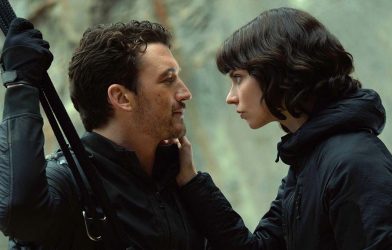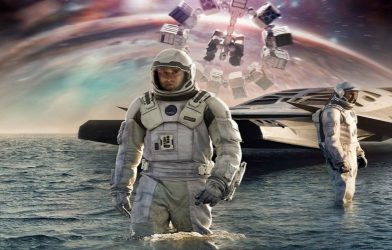A common trope in the hero’s journey, if you consult Joseph Campbell’s work, is the “refusal of the call”—the moment when the protagonist declines the adventure ahead of them, upping the stakes for whatever comes next. But in Indiana Jones and the Dial of Destiny, the latest installment of the Indiana Jones series, our familiar hero (played by the now-80-year-old Harrison Ford) is too jaded to bother with much of anything. Instead, shirtless on his easy chair and toting a glass of whiskey, he’s introduced fast asleep before he shuffles to his professorship at New York’s City College and accepts a cheesy retirement gift from his co-workers. “Thanks for putting up with me,” he mumbles, to a few scattered claps.
This is the fifth Indiana Jones film but the first in 15 years, following 2008’s Kingdom of the Crystal Skull—a movie that was itself happy to dispense gags about Ford’s increasing creakiness. Dial of Destiny knows it cannot retreat from its star’s advancing age, so it leans all the way in, spinning a yarn in which the whip-toting archaeologist confronts—and eventually rebuffs—his perceived uselessness by going on one more quest around the world in search of an ancient doohickey. The film, directed by James Mangold, still has a streak of defiance, but it’s a gentle one, working to avoid the relative strangeness of Crystal Skull and instead give viewers exactly what they might expect.
Mangold is an incredibly reliable purveyor of blockbuster fare who can punch above his weight in almost any genre. His two comic-book movies, The Wolverine and Logan, were gritty and thoughtful works; he also makes an excellent noir (Cop Land), Western (3:10 to Yuma), romantic comedy (Kate & Leopold), and biopic (Walk the Line and Ford v Ferrari). Still, he’s given an impossible task here: jumping on board a series where every prior entry was made by Steven Spielberg, who practically redefined the adventure film in 1981 with the first Indy movie, Raiders of the Lost Ark.
Spielberg always recognized that sequels should push against audience expectations as much as work to satisfy them. Although two of his four Indiana Jones entries (Temple of Doom and Kingdom of the Crystal Skull) are deeply bizarre and sometimes outright hostile to their viewers, they’re very interesting and watchable works. Each reflects the director’s mindset at the time—the former was made after he went through a breakup, the latter as he confronted an encroaching digital revolution in cinema. Crystal Skull ended with Indiana Jones married to his erstwhile companion Marion Ravenwood (Karen Allen), and clearly, Spielberg saw nowhere else to take the character as he approached his dotage.
Mangold doesn’t have a new angle either, instead taking Indiana down memory lane for his last hurrah. Yes, there’s personal hardship for the character to overcome: Along with his creaky bones, he’s once again estranged from Marion, having failed to assuage her grief when their son, Mutt (Shia LaBeouf), died in the Vietnam War. But Mangold figures the audience wants something familiar, so he brings a whole ensemble. Indiana quickly meets Helena Shaw (Phoebe Waller-Bridge), his fast-talking goddaughter, who drags him on a chase across the globe in search of a Greek artifact supposedly connected to time travel. There’s even a plucky street urchin named Teddy (Ethann Isidore) along to help out, plus a cameo appearance by John Rhys-Davies as the garrulous excavator Sallah.
In pursuit, as is often the case with Indiana Jones, are a bunch of Nazis. Because the movie is set in the late ’60s, the Nazis are a little quieter about their beliefs—the lead villain, Jürgen Voller (Mads Mikkelsen), is a rocket scientist recruited by NASA as part of Operation Paperclip. Still, their nefarious goals and love of ancient magical gear makes them fundamentally indistinguishable from the archenemies of Raiders of the Lost Ark and Indiana Jones and the Last Crusade, also known as the Indiana Jones movies that everyone can agree are good. And just in case viewers didn’t get the message, there’s a nostalgia-focused opening action sequence that sees a de-aged Harrison Ford fighting a bunch of Nazis during a World War II mission—a set piece that is technically competent but can’t avoid the hollow, rubbery uncanny valley of Indy’s CGI face.
Most of the film has Indy and his traveling companions and Nazis in pursuit of the magic relic, functioning like clockwork as the company hops to locales such as Morocco and Greece. But though Ford invests his performance with as much longing and nuance as he can, underlining Indiana’s increasing disconnection from the modern world, the movie is too busy to really plumb those themes, instead zipping along to the next action sequence lest anyone get bored.
The closing act of Dial of Destiny is also in the grand tradition of Indiana Jones movies, throwing a mixture of history, pseudoscience, and supernatural elements into the plot and abandoning the relatively grounded material that preceded it. Still, I was happiest then, bouncing in my seat as Indiana and his pals were confronted with a head-scratching metaphysical quandary, which contained a lot more than the hoary wisecracking of the film’s first two-thirds. I thus left Dial of Destiny vaguely satisfied that this presumably final entry at least didn’t do anything to truly pervert the character’s legacy. But that sense of safety cuts both ways: Yes, it’s hard to be mad at this movie, but it’s also hard to summon any other strong emotion. If Ford really wants to bring the character out of the barn again, there’s clearly little to stop him—but I hope Indy retires back to his easy chair after this, and is left truly alone.









